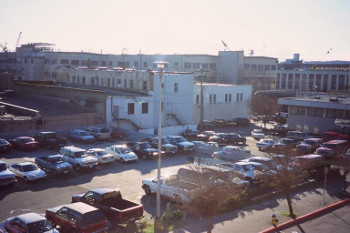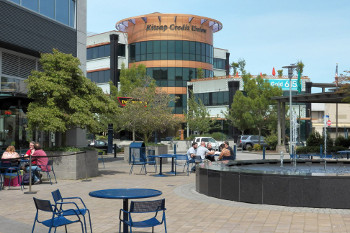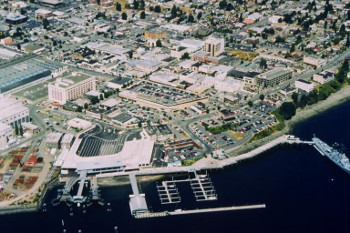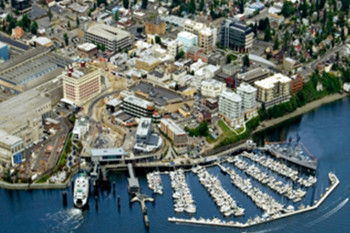Examining Obstacles to Infill Development
A Project of the California Planning Roundtable
Matthew Taecker AIA AICP and Stan Hoffman FAICP
Why is Infill Important?
Mounting evidence points to the need for successful infill development. Building more densely where there is existing transit, infrastructure and conveniences is widely recognized as essential for meeting social, economic and environmental challenges – not the least of which is how to accommodate California’s rapid growth. Infill development can simultaneously revitalize our established communities. It can transform underused areas into vibrant people places that add housing along transit routes, increase walkability and the availability of local destinations, upgrade aging infrastructure, help balance jobs and housing, and replace vacant or underutilized parcels and parking lots with pedestrian-friendly buildings.
Community members often greet infill proposals with skepticism and resistance. Infill can fail to “fit in” or fail to deliver benefits. Furthermore, local governments can have policies that frustrate infill development, and may lack infrastructure and other critical resources required to support it.
Locating, designing and implementing infill development presents numerous challenges and requires thoughtful planning, creative design and active stakeholder engagement.
This project provides a framework and a practical guide for the practicing planner, urban designer, local officials, and the general public -- as they seek to implement infill development Guidance comes in the form of articles, as well as organizations and other resources that focus on infill.
Examining Obstacles
The California Planning Roundtable (CPR) is creating this web-based resource guide for community decision makers, urban planners, and anyone interested in advancing infill development. CPR’s “Infill Project” examines principal hurdles to infill development across major arenas: cultural, political, financial, and legal. The project will identify chief impediments to infill development, and recommend promising policies, practices and tools.
Over the next several months CPR members will examine obstacles to infill development with a series of concise peer-reviewed articles. Topics will include:
- Facing Opposition to Infill: Still Passionate About Planning. Vivian Kahn describes how infill development needs to be connected to clear measurable community benefits to gain both political and community acceptance of infill development.
- Encouraging Infill through Impact Fee Design. Marc Roberts describes how municipal governments adopt development impact fees that -- when considered together -- can make or break the finances of infill development, and – if properly shaped – can better address community objectives.
- Infill Infrastructure Planning. Jeff Lambert llustrates how limited infrastructure capacity can be an obstacle to infill development, and describe measures to deliver infill infrastructure more effectively.
- Financing Infill Development, Post-Redevelopment. Stan Hoffman and Bill Anderson examine public finance tools available to support urban infill, and describe their limitations. The recommend refinements to existing tools and describe financing implementation tools that may still be needed.
- Best Practices for Implementing a Community Benefits Program. Hanson Hom, Vivian Kahn and Matt Taecker looks at community benefits programs, which offer additional development capacity in exchange for community benefits that would not otherwise be required. The paper describes how programs can leverage benefits, but also how they can have unintended consequences if economic and market conditions aren’t right.
- Evaluating Infill: A Cross Disciplinary Framework. Liz Falletta how infill development involves different types of stakeholders, and how their perspectives often differ. Cross-disciplinary engagement promotes mutually beneficial outcomes.
- Contextual Design. Matt Taecker will consider how context-sensitive development can reflect each community’s unique character and gain broad-based acceptance -- while simultaneously allowing needed growth.
- Growing In Town. Tony Lashbrook will present the example of Truckee California’s Railyard Master Plan – a whole new neighborhood next to Truckee’s downtown – which succeeds by embracing walkability, land use mix, innovative design and historic traditions.
- Maintaining Financial Feasibility. Mark Rhoades will describe economic challenges that often face infill development, and policy factors that can determine whether infill is more or less likely to happen.
- Managing Parking. Based on recent transportation studies and case examples, Stan Hoffman and Matt Taecker will illustrate how on-site parking requirements affects the feasibility of infill development, and how transit access and other alternative modes can play a key role.
- Environmental Footprint. Local environmental effects from infill development can obscure its regional and global benefits in reducing the consumption of energy and other natural resources and in stemming global climate change – evidence for which will be provided by Matt Taecker.
- Access to Opportunity. Stan Hoffman will consider how infill locations can enhance access to diverse job types and wage opportunities and affordable housing -- key aspects of social equity – such as with mixed use development and better connections via transit.
- Regulatory Streamlining. Vivian Kahn will consider the effects that municipal legal authority and environmental review can have on infill development, and how to reform practices to avoid unintended negative consequences.
- Social Equity. CPR members on the forefront of social equity advocacy will describe how infill development can benefit people of all incomes and backgrounds, particularly disadvantaged communities. Infill policies and programs can boost job creation and affordable housing production, and mitigate gentrification pressures that can accompany infill.
Readers are encouraged to contribute comments that draw from their own infill development experience. Articles will also be peer-reviewed by invited professionals. The articles will be compiled and published – in both electronic and hard copy – as a comprehensive and practical guide.
CPR appreciates your interest in the Infill Project. Please return to find new articles and resources as the project progresses.


Infill development has transformed downtown Bremerton, Washington, from a landscape of economic malaise, riddled with parking lots and underutilized land, to being a thriving urban center. At left, 1995 conditions near Bremerton's regional ferry terminal. At right, relatively new mixed-use development frames a plaza and offer street-level amenities. Photo credits: Matthew Taecker.


Aerial photos from 1995 (left) and 2010 (right) show Bremerton's remarkable intensification that includes a mix of waterfront housing, office space, new cultural uses, and main-street retail. Photo credits: City of Bremerton.
